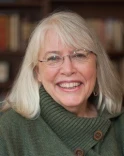When the University of Maryland College of Special and Continuation Studies—now University of Maryland Global Campus (UMGC)—was established 75 years ago, it launched a force in higher education that has helped generations of students earn degrees, move forward in their careers and ensure the financial wellbeing of their families. This legacy was built on recognizing the powerful potential of adult learners, by embracing technology that disrupts how and when people study and by re-envisioning the very role of higher education.
UMGC’s openness to experimentation, norm disrupting, and boundary crossing has yielded a global platform that is remarkable in its scope, longevity and results.
“Today, we are proud to offer over 135 programs … serve nearly 90,000 students, including more than 55,000 servicemembers, veterans and their families, at over 175 locations around the world,” said UMGC President Gregory W. Fowler. “And we continue to innovate and create new opportunities for our students to succeed again—so they can achieve their academic, personal and professional goals.” This month, UMGC marks its 75th anniversary as a game-changing academic institution. In honor of this Diamond Anniversary, a campaign of social media posts and videos will deliver “75 Unbreakable Diamonds”—high points and superlatives associated with the university—in conjunction with other anniversary activities.
It was a bold move in 1949 when UMGC, at the request of the Department of Defense, became the first institution to send a team overseas to teach active duty servicemembers stationed in war-torn Germany. Over the next seven decades, UMGC educational programs spread from bases in Europe to military locations in Asia in 1956 and, later, to combat zones and even U.S. embassies around the world.
Indeed, the long roster of cities and countries where UMGC has planted its flag reads like a geography lesson and spreads across all seven continents: from Heidelberg and Tokyo to Cairo and Cypress, from Hong Kong and Iceland to Iran and Kuala Lumpur. UMGC faculty have worked in the Midway Islands, Morocco, Portugal, Subic Bay in the Philippines and the Indian Ocean atoll of Diego Garcia. Just for starters.
As recently as two decades ago, adult learners were often overlooked by other traditional institutions. But UMGC saw the potential of students who otherwise were barred from a college degree—because they couldn’t afford it, lived too far from a university, carried too many family responsibilities, had competing work obligations or didn’t believe they were college material.
Today, veterans, servicemembers and their family members graduate alongside other adult learners of all ages, from all backgrounds. Two-thirds of the UMGC enrollment is made up of first-generation students.
“From its inception, this institution has been student centered in every sense of that phrase,” said Fowler. “Few institutions can boast such a colorful record of working with students in most unusual, and often adverse, conditions.”
“Unusual” and “adverse” may be understatements. Julian Jones, vice president emeritus of Overseas Programs, taught on an active B-52 base in Thailand before and during the Christmas bombing of Hanoi in 1972.
“I saw some of the planes come back to base on fire, and ambulances rushed out to take crew out,” Jones recalled.
His roommate was an electronics warfare officer on a B-52 and they became friends.
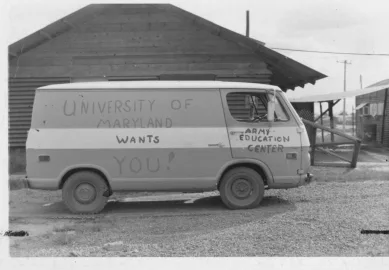
“Although he had a degree, he came to some of my classes, especially those in my specialty, Human Aggression and War,” Jones said. “[He was lost when] his plane was shot down over Hanoi, and the cost of the war became more personal and less academic to me, as I told my class.”
Joe Arden was one of the first UMGC faculty members to teach servicemembers in Vietnam during the Vietnam War. He became director of the university’s Far East Division in 1975 when the Vietnam War came to an end—and found himself with an unusual task.
“It fell to me to deal in an equitable manner with the ‘incompletes’ from several … courses that were interrupted [or] canceled by the April 1975 evacuation of American personnel from Saigon,” Arden recalled as part of a memoir project organized by the Overseas Marylanders Association (OMA), a group of former and current faculty and staff members who have served overseas. “This presented numerous challenges not normally posed in higher education.”
Vietnam was just the beginning of UMGC’s experience in war zones. Nearly 40 years after the fall of Saigon, Andre Washington, an IT specialist with the U.S. Army, was in the middle of a UMGC computer science certification course on a base in Afghanistan when mortar fire hit.
“We were in class in full gear—Kevlar, helmets, anything else that was considered protective gear. The instructor had his gear on, too,” Washington said. “The entire class hit the floor as mortar fire slammed the buildings nearby and set off shockwaves.”
When the assault ended, Washington said, “We all got up and resumed the class.”
UMGC alumni and faculty have no shortage of stories about teaching amid war. With the university’s push to carry education to adult learners beyond the military, those tales are now joined by stories from civilian students who overcome daunting personal hurdles to earn their degrees.
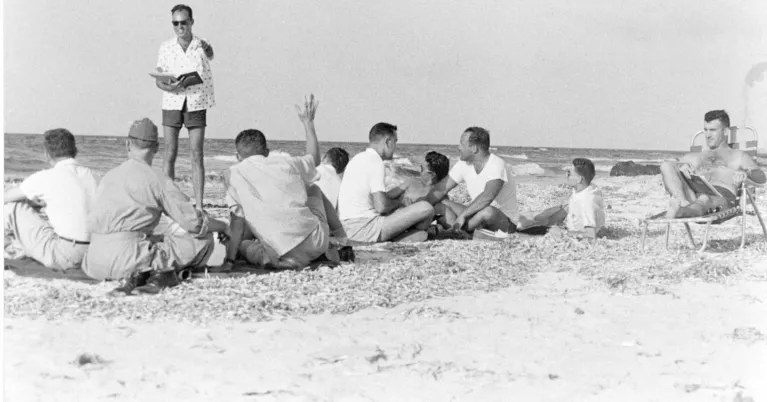
There were many reasons for UMGC to move beyond military education. On a practical level, the waning days of the Cold War and the drawdown of troops created new opportunities for faculty and in the 1980s, the university began thinking about developing civilian education programs outside the United States. By coincidence, that was about the same time that James Cramer, who worked in the European Division in 1974 and 1975, received a surprise phone call from an administrator at Sophia University in Tokyo.
“He was putting together a training program for Japanese business managers for the world’s largest advertising company, Dentsu Inc.,” Cramer noted in the OMA memoir project.
Cramer developed a one-week course in international management as part of a collaboration with Sophia.
“The Dentsu program became a regular event scheduled two, sometimes three, times each year,” Cramer noted. “Soon the people from Sophia faded away, leaving me with the responsibility to design, develop and teach programs for Dentsu.”
That program for Japanese business executives mushroomed into UMGC’s International Business and Management Institute (IBMI) in Tokyo. Its students came from Fujitsu, Itochu, Mitsubishi, Sony and other big companies, and the enrollment skyrocketed as Japanese firms sent their managers for training workshops before they were assigned to operations in the United States.
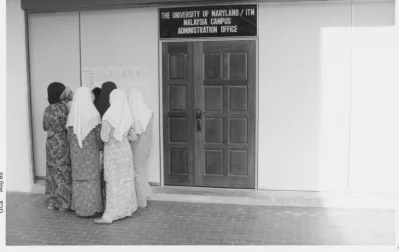
As the Cold War thawed, UMGC looked for nonmilitary educational partnerships overseas. Its first was a collaboration with the Ministry of Education in Malaysia.
IBMI was followed by another non-military initiative, this time with the Ministry of Education in Malaysia. To save on its investment in students interested in U.S. degrees, the ministry required students to complete two years of in-country study at the Mara Institute of Technology outside Kuala Lumpur before heading to the United States. The ministry wanted UMGC to develop those two years of educational programs.
Today, UMGC has an array of alliances that are geared toward workforce development and providing access to the university’s more than 135 programs for a host of organizations that are leaders in their industries, including Amazon, Uber Technologies, Subway, Papa John’s Pizza, as well as the federal government’s Office of Personnel Management, the National Football League Players Association, and Guild Education’s network of employer partners.
UMGC has also been in the forefront of increasing access and affordability to a bachelor’s degree through alliances with all 16 Maryland community colleges and community college systems in 24 other states, including California, Colorado and Kentucky. Students who complete associate degrees at partner community colleges are automatically admitted to UMGC and can pursue a four-year degree—with discounted tuition and other benefits.
UMGC’s expansion has been possible to a large degree because of its willingness to embrace innovation. The university recognized that stateside students needed a way to learn free of long car commutes or the hiring of babysitters. Servicemembers in places like McMurdo Station in Antarctica didn’t want to be shut out of degrees because of their remote location. And overseas military members returning stateside wanted an opportunity to continue—and complete—their UMGC degree programs.
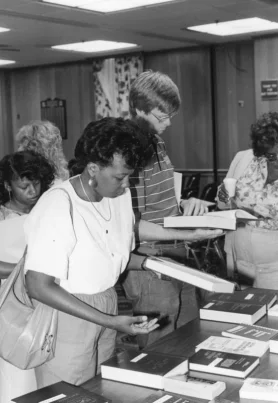
So, the university turned itself into a real-time lab for distance learning. Correspondence courses through military newspapers were replaced with independent study that involved tutors, videotapes and radio broadcasts. In 1993, UMGC unveiled its “virtual university,” offering students across the country the ability to complete a bachelor’s degree via computer conferencing and e-mail. A year later, UMGC students were using their personal computers and dial-up modems to get everything they needed for their courses, including access to discussion groups.
As technology advanced, online programs became the predominant way to learn at UMGC. In 2020, when the COVID-19 pandemic forced schools and universities around the globe to shift online, UMGC was ahead of the game. It had been teaching on virtual platforms for years.
This fall it becomes one of 10 schools in a special immersive learning pilot program using virtual reality (VR) that provides students in certain courses with Oculus Quest 2 virtual reality headsets so they can interact with other students and faculty on a “metacampus.”
Through its 75 years, as UMGC changed who has access to an education and how it is delivered, it also stepped up as a champion of high-quality teaching. When many universities were spotlighting faculty research credentials, UMGC was focused on elevating pedagogy.
In 1975, for example, T. Benjamin Massey, then director of the university’s European programs (and later UMGC’s president for 20 years), launched the first International Conference on Improving University Teaching (IUT) as a counter to mediocre teaching in higher education. The IUT conference continued under UMGC’s umbrella for 27 years before spinning off as an independent global program. In July, the 48th annual IUT was hosted by Ilia State University in the country of Georgia.
Stateside, meanwhile, UMGC embedded faculty development into its operations. When it added a free-standing instructional design unit at the university’s Adelphi headquarters in the 1980s, it was two decades ahead of most universities.
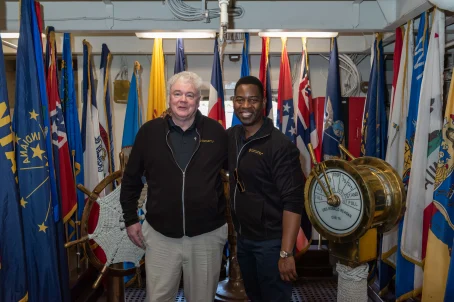
During his visit to the Asia Division in 2022, UMGC President Gregory Fowler (right) and division director James Cronin tour the aircraft carrier USS Ronald Reagan.
A commitment to students—the driver of UMGC’s work—has also pushed the university to be inventive. In 2016, it was the first major university to replace textbooks with digital resources, at no cost to students, for most undergraduate classes. That decision saved students an estimated $17 million in the first year alone. Earlier this year, U.S. News & World Report ranked UMGC No. 1 in the nation in the number of transfer students accepted, the result of policies and strategies that protect students’ transfer credits and expedite enrollment. The Pillars of Strength Scholarship, meanwhile, has provided full tuition scholarships since 2013 for a demographic that receives little support otherwise: the volunteer caregivers of injured or wounded servicemembers.
Seventy-five years after its founding, UMGC—with its year-round academic calendar and emphasis on “meeting students where they are”—is holding firm to its mission: to inspire hope, empower dreams and transform lives … one student at a time.
